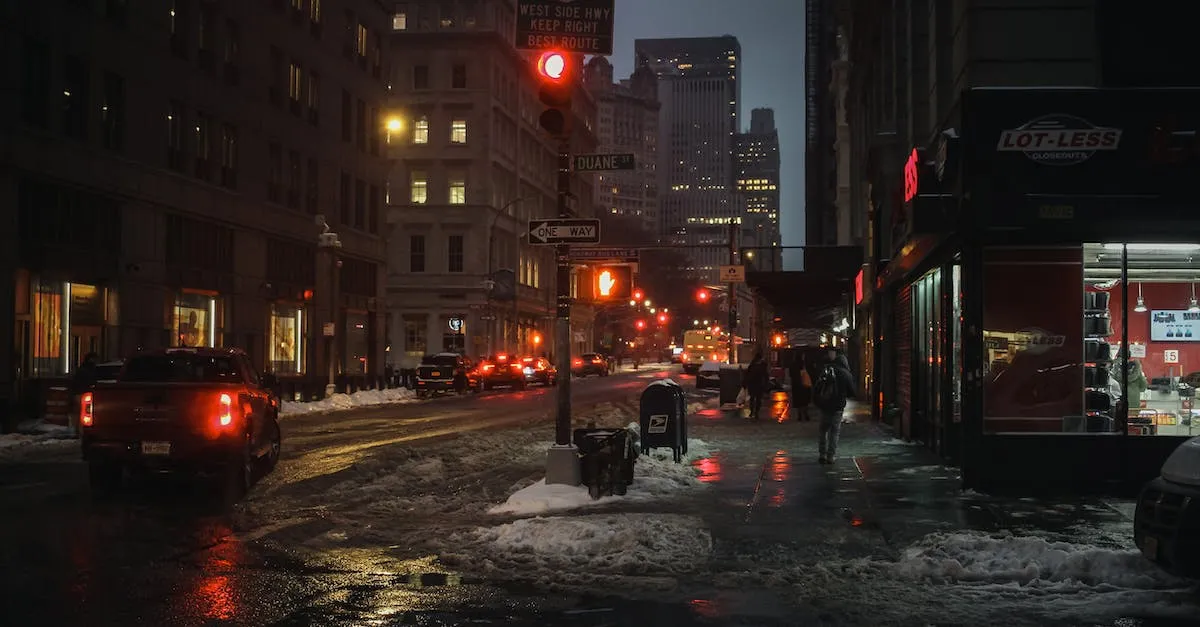Does It Snow In New York City?
Whether you’re planning a trip to New York City or just curious about the weather, you may be wondering: does it snow in the Big Apple? The short answer is yes, New York City definitely gets snow in the winter.
In this comprehensive guide, we’ll dive into details about snowfall in New York City, including historical records, average snow totals by month, the likelihood of snowstorms, and what to expect during a New York City winter.
Historical Snowfall in New York City
New York City is known for its bustling streets, towering skyscrapers, and vibrant culture. However, one question that often comes to mind is whether it snows in the Big Apple. The answer is a resounding “yes.”
While the city may not experience snowfall as frequently as some other parts of the country, it has seen its fair share of snowstorms throughout history.
Record Snowstorms
Over the years, New York City has been hit by several significant snowstorms that have left residents and visitors alike in awe. One of the most memorable snowstorms occurred on February 11-12, 2006, when a whopping 26.9 inches of snow fell in Central Park.
This storm, known as the Blizzard of 2006, brought the city to a standstill and broke the previous record set in 1947.
Another record-breaking snowstorm took place on January 23-24, 2016, when a total of 27.5 inches of snow accumulated in Central Park. This storm, known as Winter Storm Jonas, caused widespread disruptions, including the suspension of public transportation and the closure of schools and businesses.
Snowiest Months and Seasons
When it comes to the snowiest months in New York City, January and February take the lead. These two months typically experience the highest snowfall amounts due to the city’s proximity to the Atlantic Ocean and the prevalence of cold air masses from the north.
On average, January receives around 7.6 inches of snow, while February sees an average of 9.4 inches.
In terms of seasons, winter is, unsurprisingly, the snowiest time of the year in New York City. From December to March, the city sees a significant amount of snowfall, with an average of 25.8 inches throughout the season.
However, it’s worth noting that snowfall can occur as early as November and as late as April, adding to the city’s wintery charm.
Changes Over Time
While New York City has had its fair share of snowstorms throughout history, there have been noticeable changes in snowfall patterns over time. Climate change has brought about warmer temperatures, which can affect the amount and frequency of snowfall in the city.
However, it’s important to note that individual snowstorms can still bring substantial amounts of snow, even in a warmer climate.
If you’re planning a trip to New York City during the winter months, it’s always a good idea to check the weather forecast and be prepared for the possibility of snow. The city’s snow removal efforts are extensive, ensuring that the streets and sidewalks are cleared as quickly as possible to minimize disruptions.
So, embrace the winter wonderland and enjoy the beauty of New York City covered in a fresh blanket of snow.
Average Monthly Snow Totals
December
In New York City, December marks the beginning of the winter season and the possibility of snowfall. On average, the city receives X inches of snow during this month. However, it’s important to note that snowfall amounts can vary greatly from year to year.
Some years, December might see heavy snowstorms blanketing the city, while other years might see little to no snowfall at all.
January
January is typically the coldest month in New York City, and it is also a time when snowfall is common. On average, the city receives X inches of snow during this month. The combination of cold temperatures and precipitation can create picturesque winter scenes throughout the city, with snow covering the streets, parks, and rooftops.
New Yorkers and visitors alike can enjoy activities such as building snowmen, having snowball fights, and even skiing or snowboarding in nearby areas.
February
February continues to bring the possibility of snowfall to New York City. On average, the city receives X inches of snow during this month. This is a time when the city might experience some of the heaviest snowfalls of the winter season.
While it can make commuting and getting around the city more challenging, it also provides an opportunity for residents and tourists to appreciate the beauty of a winter wonderland in the heart of the city.
March
As winter transitions into spring, March can bring a mix of weather conditions to New York City. While snowfall is still possible, it tends to occur less frequently. On average, the city receives X inches of snow during this month.
However, the temperatures begin to rise, and the snow that does fall often melts quickly. March is a time of transition, where the city starts to come alive with signs of spring, but the occasional snowfall reminds everyone that winter hasn’t quite let go just yet.
April
By April, New York City is usually experiencing milder temperatures and the arrival of spring. While snowfall is rare during this month, it is not unheard of. On average, the city receives X inches of snow during April.
However, any snow that does fall is usually light and melts quickly as the sun becomes stronger and the days grow longer. April is a time of hope and anticipation, as New Yorkers eagerly await the arrival of warmer weather and the blossoming of flowers throughout the city.
For more information about New York City weather and snowfall statistics, you can visit the Weather Channel website or the National Weather Service website.
Likelihood of Snow Each Winter
First & Last Snowfalls
Winter in New York City is often associated with snowfall, but the exact timing and amount of snow can vary from year to year. The first snowfall of the season typically occurs in late November or early December. However, it’s not uncommon for snowflakes to make an appearance as early as October.
On the other hand, the last snowfall usually happens in March or early April, with occasional snow showers extending into April. These dates can fluctuate depending on weather patterns and climate changes.
Frequency of Measurable Snow
New York City experiences measurable snowfall, typically defined as 0.1 inches or more, several times throughout the winter season. On average, the city sees about 25 days with measurable snow each year.
However, it’s important to note that not all of these snow events lead to significant accumulations. Some snowfalls may only leave a light dusting, while others can bring several inches of snow. The amount of snowfall can vary greatly from year to year, with some winters receiving above-average amounts of snow, and others experiencing below-average snowfall.
According to the National Weather Service, the snowiest winter on record in New York City occurred during the 1995-1996 season when a total of 75.6 inches of snow fell. In contrast, the least snowy winter was in 1972-1973, with only 2.8 inches of snow recorded.
These extremes illustrate the variability of snowfall in the city.
If you’re looking for more detailed and up-to-date information on snowfall in New York City, you can visit the National Weather Service’s website for historical data and forecasts. It’s important to stay informed about winter weather conditions, especially if you’re planning to travel or engage in outdoor activities during the snowy season.
What to Expect During a NYC Winter
Winter in New York City can be a beautiful and magical time, but it also comes with its fair share of challenges. One of the most common questions people have is whether or not it snows in the city. The answer is a resounding yes!
Snowfall is a regular occurrence in New York City during the winter months, transforming the bustling streets into a winter wonderland.
Snowstorm Preparations
When a snowstorm is on the horizon, New Yorkers know how to prepare. The city’s Department of Sanitation goes into overdrive, mobilizing its fleet of snowplows and salt spreaders to keep the streets clear and safe.
Residents are advised to stock up on essentials like food, water, and batteries, as well as to have a shovel and ice melt on hand for their own sidewalks and driveways. It’s also a good idea to check local news and weather updates to stay informed about any advisories or closures.
Travel Difficulties
While snowfall can be a sight to behold, it can also cause travel disruptions. The combination of snow and the city’s bustling transportation system can lead to delays and cancellations. Airports, train stations, and bus terminals may experience service interruptions, so it’s important to check with your airline or transportation provider before heading out.
Additionally, navigating the streets of New York City can be challenging during snowy conditions, as roads may be slippery and visibility may be reduced. It’s advisable to take public transportation whenever possible or allow for extra travel time if driving is necessary.
Dealing With Slush and Ice
Once the snow starts to melt, New Yorkers are faced with another obstacle – slush. The combination of melting snow and foot traffic can create messy and slippery conditions on sidewalks and crosswalks.
It’s important to wear appropriate footwear with good traction and to exercise caution when walking. The city’s Department of Sanitation works diligently to remove the slush and ice, but it’s always a good idea to be mindful of your surroundings and take extra care to avoid any potential slips or falls.
Conclusion
So in summary, yes it definitely snows in New York City almost every winter. The city sees an average of nearly 30 inches of snow per season, with January typically being the snowiest month. Major snowstorms can bring over a foot of accumulation and cause major disruptions to travel and daily life in the city. By understanding typical NYC snow patterns, you can be prepared if you’re planning a winter trip to the Big Apple.








